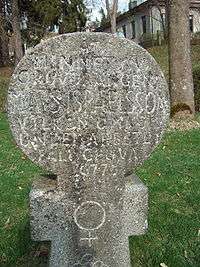Fet-Mats

Fet-Mats ("Fat Mats") (real name: Mats Israelsson) (died 1677) was a "petrified man" found in 1719.
In 1719, miners in the Falun copper mine found an intact dead body in a water-filled, long-unused tunnel. When they brought the body to the surface, it was identified by his former fiancée, Margaret Olsdotter, as Fet-Mats Israelsson, who had disappeared 42 years earlier.
In the open air the body dried up and turned hard as a rock. People gave it a nickname "petrified miner". Fet-Mats Israelsson was put on display on Stora Kopparberget.
When the naturalist Carl Linnaeus visited, he noticed that Fet-Mats was not petrified but just covered with vitriol. He stated that as soon as the vitriol evaporated, the body would begin to decay.
That proved to be correct. Fet-Mats Israelsson was buried in The Stora Kopparbergs Church December 21, 1749. During the change of the floor in early 1860, the remnants of Fet-Mats was found again and exhibited in a display case, until he was finally buried 1930 in the cemetery nearby the church.
Fet-Mats became an inspiration for the German romanticists. The philosopher and naturalist Gotthilf Heinrich von Schubert wrote about him in Ansichten von der Nachtseite der Naturwissenschaft, Achim von Arnim wrote a ballad about Fet-Mats, Johann Peter Hebel wrote a short story about him called Unverhofftes Wiedersehen (Unexpected Reunion). Friedrich Rückert also wrote about Fet-Mats but most of all E.T.A. Hoffmann wrote the short story Die Bergwerke zu Falun published in his collection Die Serapionsbrüder in 1819. In 1842 Richard Wagner wrote a libretto based on Hoffmann's short story called Die Bergwerke zu Falun, but it was refused and instead he wrote Tannhäuser. In 1901 Hugo von Hofmannsthal's Das Bergwerk zu Falun had a premiere in Vienna.